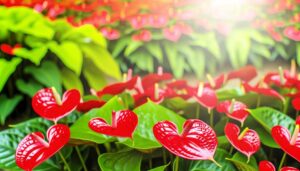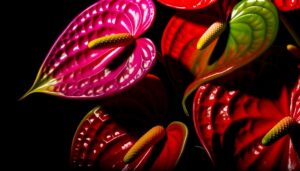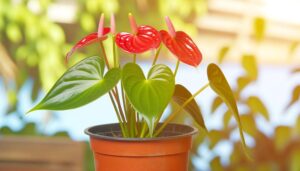7 Steps to Growing Anthuriums Outdoors in Hawaii
To grow anthuriums outdoors in Hawaii, start by selecting a location with filtered sunlight and ideal humidity. Prepare well-draining, organic-rich soil and amend with perlite.
Plant healthy seedlings with proper spacing. Water thoroughly but infrequently using rainwater or distilled water, letting the topsoil dry between waterings.
Fertilize with a slow-release formula and maintain soil health with regular pH checks and foliar feeding. Monitor for pests like aphids and implement integrated pest management.
Regularly prune dead leaves and old blooms. Ensure proper air circulation to prevent fungal disease.
Continue on for complete care techniques and advanced tips.

Key Takeaways
- Choose a location with filtered sunlight and optimal humidity levels for anthuriums.
- Ensure well-draining, organic-rich soil by amending it with compost and perlite.
- Water thoroughly but infrequently, allowing the topsoil to dry out between waterings.
- Apply slow-release fertilizer regularly and supplement with foliar feeding.
- Monitor for pests and diseases, using integrated pest management strategies and promoting good cultural practices.
Choose the Right Location
Selecting a best site for growing anthuriums outdoors in Hawaii requires careful consideration of specific environmental factors such as light exposure, humidity levels, and soil composition. Anthuriums thrive in areas receiving filtered sunlight, mimicking their natural understory habitat. Direct sunlight may scorch their delicate foliage, so position them under partial shade or use shade cloths.
Optimal humidity levels range between 70-80%, necessitating a site that maintains consistent moisture without waterlogging. Air circulation is essential, as stagnant conditions can promote fungal diseases. Soil composition should be well-draining and rich in organic matter.
Ensure the selected location allows for adequate spacing to facilitate growth and air movement. Proper site selection is crucial for cultivating healthy, vibrant anthuriums.
Prepare the Soil
Preparing the soil for anthuriums involves amending it to achieve a well-draining, nutrient-rich medium that promotes healthy root development and prevents waterlogging. Begin by incorporating organic matter such as compost or well-rotted manure to enhance soil structure and fertility.
Ensure a pH range of 5.5 to 6.5, which is ideal for anthuriums, by testing and adjusting with lime or sulfur as needed. Add perlite or coarse sand to improve drainage and aeration, preventing root rot. For areas with heavy clay, consider raised beds to further optimize drainage.
Thoroughly mix all amendments into the top 12 inches of soil to create a homogeneous growing environment. Proper soil preparation is essential for the robust growth and vibrant blooms of anthuriums.
Planting Anthuriums
To plant anthuriums outdoors in Hawaii, begin by selecting healthy, disease-free seedlings or mature plants and positioning them in the prepared soil at a spacing of 12 to 18 inches apart. Check that each plant's root ball is adequately covered with soil, leaving the crown slightly above ground level to prevent rot.
The planting site should offer partial shade, as direct sunlight can scorch the leaves. Utilize well-draining soil, enriched with organic matter, to maintain peak aeration and moisture levels. Avoid compacting the soil around the roots, as anthuriums thrive in loose, airy substrates.
Mulch lightly around the base to conserve moisture and suppress weed growth, ensuring the mulch does not come into direct contact with the plant stems.
Watering Techniques
Maintaining ideal moisture levels is crucial for anthurium health, requiring a strategic approach to watering that balances hydration with the plant's native inclination for well-draining environments. Water anthuriums thoroughly but infrequently, making sure the top inch of soil dries between waterings. Avoid waterlogging, as excessive moisture can lead to root rot. Utilize rainwater or distilled water to prevent mineral buildup.
| Watering Schedule | Guideline |
|---|---|
| Early Morning | Best time for watering |
| Frequency | 2-3 times per week in warm months |
| Water Volume | Deep watering until runoff appears |
| Soil Check | Confirm top inch is dry before next |
| Rain Consideration | Adjust based on recent rainfall |
Monitor ambient humidity and adjust practices accordingly to ensure the plant's health.
Fertilizing Tips
Perfect fertilization of anthuriums in Hawaii involves the application of a well-balanced, slow-release fertilizer with a ratio of 20-20-20, guaranteeing essential nutrients are consistently available to support strong growth and vibrant blooms.
Apply the fertilizer every 8-10 weeks, integrating it evenly into the soil around the plant's root zone. Avoid direct contact with the stem to prevent burn damage.
Evaluate soil pH regularly; anthuriums thrive in slightly acidic conditions, with an ideal pH range of 5.5-6.5. Supplement slow-release fertilizers with occasional foliar feeding using a diluted liquid fertilizer (1/4 strength) to promote leaf health.
Opt for proper irrigation post-fertilization to facilitate nutrient uptake, avoiding waterlogged conditions which may lead to root rot.
Pest and Disease Control
Effective pest and disease control for anthuriums in Hawaii requires vigilant monitoring for common issues such as aphids, mealybugs, scale insects, and fungal infections, implementing integrated pest management (IPM) strategies to maintain plant health.
Regularly inspect plants for early signs of infestation or disease. Employ biological controls, such as introducing beneficial insects like ladybugs for aphid control. Chemical treatments should be used judiciously; opt for insecticidal soaps or neem oil for minor infestations.
Promote proper cultural practices, including adequate spacing for air circulation and avoiding overhead watering to minimize fungal diseases. Sanitize tools and remove any infected plant material promptly to prevent pathogen spread.
Consistent monitoring and preventive measures are essential to sustaining healthy anthurium growth.
Pruning and Maintenance
Pruning and maintenance of Anthuriums in Hawaii involve the strategic removal of dead leaves to prevent fungal infections and facilitate air circulation.
Encouraging new growth is vital, achieved by trimming back old blooms and ensuring the plant's energy is directed towards healthy development.
Additionally, regular inspection and pruning play an integral role in pest and disease control, maintaining the overall health and aesthetic of the plant.
Removing Dead Leaves
Proper elimination of dead leaves from anthuriums is vital for maintaining plant health and promoting robust growth. Begin by sterilizing pruning shears with isopropyl alcohol to prevent pathogen transmission.
Identify dead or yellowing leaves, which can harbor pests and diseases if left unattended. Hold the base of the leaf petiole firmly and cut cleanly at the point where it meets the main stem, ensuring no residual tissue is left.
Dispose of the pruned material away from the plant site to avoid recontamination. Regular inspection and removal of senescent foliage should be conducted bi-weekly to keep the anthuriums in best condition.
This meticulous approach to pruning facilitates air circulation and light penetration, ideal for the plant's health.
Encouraging New Growth
To stimulate vigorous new growth in anthuriums, it is important to employ targeted pruning techniques and maintain ideal environmental conditions. Begin by removing any senescent or damaged leaves using sterilized pruning shears to prevent pathogen transmission. Focus on cutting back to a node, making angled cuts for optimal wound healing.
Regularly inspect the plant for excessive density, thinning out congested areas to enhance airflow and light penetration. Apply a balanced, slow-release fertilizer, rich in phosphorus, to promote root and shoot development.
Maintain ambient temperatures between 70-85°F and ensure consistent humidity levels above 60%. Proper irrigation practices, avoiding waterlogged conditions, are essential for root health. By following these guidelines, you will foster robust anthurium growth and sustained health.
Pest and Disease Control
Efficient pest and disease control in anthuriums requires careful pruning techniques and attentive maintenance routines. Regularly examine plants for indications of pests such as aphids, mealybugs, and scale insects. Manually eliminate these pests or use insecticidal soap.
Trim any diseased or injured leaves promptly to hinder the spread of pathogens. Sterilize pruning tools with a 10% bleach solution to reduce the risk of cross-contamination.
Ensure ideal air circulation by spacing plants appropriately, which decreases moisture levels favorable to fungal growth. Administer fungicides as a preventive measure, particularly during the rainy season.
Monitor the soil for proper drainage, as waterlogged conditions promote root rot. Consistent implementation of these practices will maintain anthurium health and vitality.
Conclusion
To wrap up, mastering the cultivation of anthuriums outdoors in Hawaii demands a meticulous approach, similar to crafting a delicate piece of art.
By selecting a prime location, preparing the soil, following precise planting techniques, implementing effective watering and fertilizing strategies, and diligently managing pests, diseases, and pruning, one can achieve vibrant and healthy anthuriums.
These steps, when carried out with precision, can transform a garden into a vivid tapestry of botanical beauty, showcasing the horticultural prowess of the cultivator.






